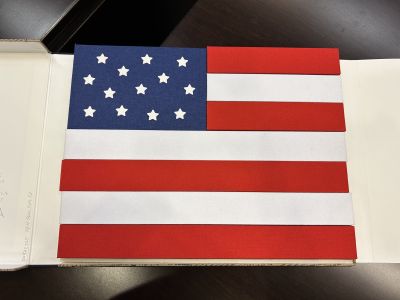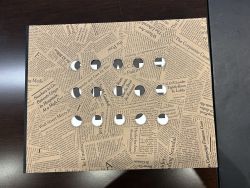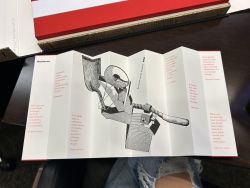The American Flag: Reconstructed

What is the American flag as we know it? 50 stars on a blue background with 13 red and white stripes. Werner Pfeiffer, an author and artist, creates a reconstruction of the American flag in his work State of the Union: a Snapshot of Our Political and Social Conundrum. [1] Published in 2012 by Pear Whistle Press, this artist's book depicts a slightly altered version of the American flag, with 8 different sections: one having 13 stars on a blue background and seven red and white stripes. Altogether, the contents of each section provide a brutal commentary on the social and political conditions and their relationship to money at the time of its publication. This particular copy is the seventh of 50 signed copies of this work and is located in the Kislak Center for Special Collections at the University of Pennsylvania.
Werner Pfeiffer
The author, Werner Pfeiffer was born in southwest Germany in 1937 and immigrated to the United States in 1961. At this time, he was primarily active as an art director and designer, and receive many accolades for his work from groups like the American Institute of Graphic Arts and the New York Society of Illustrators. Since being appointed Professor of Art at the Pratt Institute in New York and the director of Pratt Adlib Press, his work (sculptures, books, drawings, etc.) has also been shown in several exhibitions around the United States and around the world. Pfeiffer retired from teaching in 2002 in order to hone in on being an artist and author, as well as a proprietor for Pear Whistle Press, located in Red Hook, New York. [2]
Pfeiffer’s upbringing in Germany has thoroughly influenced his practices as an artist and author. During the time that he was in Germany, he witnessed a high level of censorship in which books were burned in post-WWII Germany. Thus, he now wishes to, “create and cherish books rather than dismantle them.” Additionally, in his artist's books, he pushes the limits of a stereotypical book and creates an interactive work that has some type of typical book format combined with novel characteristics and features. [3]
Flag, Book, Package, or All of the Above?

As stated in the introduction, this book has a very unique shape and structure. The contents are enclosed in a brown case in which the front and sides are covered in prints of snippets of news articles/titles. There are no complete articles, and many of the sentences are cut off, so readers are unable to read the entirety of the article, but by looking at the various context clues located in the titles and text, readers should be able to ascertain the sociopolitical theme of the work. However, the articles are real. The cut-off nature of the prints invites readers to explore the validity of the articles, and a quick Google search of some titles and some of the sentences leads readers directly to the actual articles. Additionally, there are 15 holes on the front cover that allow parts of the “title page” to peak through, but readers are unable to see what it actually says, enticing the reader to open the case and view the work. With the holes and the brown, cardboard-like quality of the casing, the closed book mimics a package to be carried and delivered from person to person. However, even though it mimics a package, the casing opens like a traditional book, and the hinge part, as well as the back cover, are covered in a black cloth, thereby reminding the reader that despite its fancy structure, it is still meant to mimic a hardcover book.

Opening up the cover, there’s a sheet of paper with the title of the work “State of the Union” in all capital letters, mimicking a typical title page seen in a traditional book. However, this title page lacks the publisher or the author, which draws attention away from who made the work and pulls more attention toward the contents of the work. It is folded in the opposite way of the case hinge, so the book contents themselves are still hidden from the reader.
As stated in the introduction, the content of this book is dispersed among 8 different accordion sheets that are glued to blocks that are arranged into the American flag. Of the blocks, there are 3 short stripes (2 red, 1 white), 4 long stripes (2 red, 2 white), and 1 blue block with 13 stars. The contents of the stripes are all very similar. Looking at the contents of the sheets, it looks like the author intended for them to be stretched out instead of flipped through. One side of the sheet has more article snippets that follow the theme of the block. Each block has a specific theme (business, economy, health, society, education, politics, environment), so on this side, there’s a key equation that spans diagonally in the middle of the sheet that involves that theme. In each of these equations, money is consistently in red, while everything else is black. The other side of the sheet has a print of a symbolic drawing related to the theme in black with quotes from significant political and social figures on each “page” of the accordion in small, red, italic font. In general, however, because of the fact that the image and the equation on the other sides can’t be read by “flipping through” the pages of the accordion sheet, these particular sheets are meant to be stretched out and viewed.
The block with the stars differs from the rest of the blocks in that the accordion sheet itself is very horizontally long when it’s stretched out. The contents of this sheet seem to be designed to be flipped through like a typical book today. This is because (a) there’s only content on one side of the sheet, and (b) the words and content in this sheet strictly follow the “borders” of each “page.” This part of the book contains general information about the sociopolitical background of the work and contains information about the author, materials, and publisher, making it similar to a preface in a typical book.
State of the Union: The Sociopolitical Context
The title of this work contains "State of the Union," which is a nod to the State of the Union address that is given by the president on Capitol Hill discussing the various issues facing the United States and the solutions that the president would like to pursue. This speech is mandated by the Constitution in Article II Section 3 (“He shall from time to time give to the Congress information of the state of the union...”).[4] Historically, the delivery of this address has evolved. Presidents George Washington and John Adams gave their addresses in person at Congress before President Thomas Jefferson decided to deliver written messages to Congress instead because he thought a speech was time-consuming and an imitation of the British monarchy. This practice continued until 1913, when President Woodrow Wilson gave an in-person speech to Congress, and this in-person delivery became regular following the presidency of Franklin Roosevelt. Through the advent of media and live broadcasting, the purpose of this speech has evolved as well. It now serves, “as a report to Congress and the nation on national conditions; as a platform to announce and rally support for the President’s legislative agenda for the coming year; and as a unique opportunity for the chief executive to convey a vision for the nation to Congress and the American people.” [5]
This book is a written and packaged version of the speech. Like a typical address, the work goes through a set of key points, which is represented in each of the stripes. In fact, looking at the 2012 State of the Union address, delivered by President Barack Obama, each of the topics that these stripes cover, except for society, is explicitly stated and elucidated.[6] These topics are also all referred to in some fashion in the top stories of 2011.[7] Furthermore, these speeches often use quotes and references to key historical figures, which is also done in the space around the images on each of the stripes. Additionally, the presence of news article snippets in the prints throughout the work is a reference to the way that the news and current events shape and form the current “state of the union.” The snippets are used as a background for the work in the same way that the nation’s current affairs in the news are a backdrop for the State of the Union address.
The structure and movability of this work are yet another nod to Pfeiffer’s view of the sociopolitical climate at the time of publication. As established, the work is in the form of an American flag. Usually, the flag is seen as a sacred object. It’s illegal to burn the flag, rip it up, or destroy it in any type of manner.[8] However, by splitting the flag up into different sections and giving the reader the ability to take it apart, Pfeiffer allows for his critique of the United States sociopolitical conundrum to physically break apart the flag and reveal the ugly truths of the US. Additionally, the blocks can be viewed in a non-linear fashion, meaning that the readers can choose any block to read first, second, last, etc. Having this indistinct form of navigation, Pfeiffer indicates that each of the topics addressed is of equal importance and allows the readers to form their own opinion on what is most important to the.
For the People?
Books have been a medium for political critique for quite a bit of time. In “The Political Nature of the Book: On Artists' Books and Radical Open Access,” the nature of artist books as a political medium is thoroughly explored. In this article, the author addresses the growth of artist books in the 1960s and 70s as a “circumvention of established institutions,” as artists sought to have full control over their work and to have the ability to communicate more directly to a wider audience. The self-reflexivity of the book, or rather, the way text/art in the book interacts with the materiality and structure of itself, is what defines an artist's book and opens up its sociopolitical potential. As artist books were published rather than exhibited, the book became the exhibition itself and became an alternative space for critical political art.[9]
This book embodies a political critique, yet its delivery and availability to the public are paradoxical. On one hand, the work is extremely hands-on. As stated previously, the outer part of the book is enticing because it has a unique cover and it has holes that allow the reader to see bits and pieces of the title but forces them to open the book to actually see what is written. Also, the contents of the books can’t be fully viewed unless a reader takes out the parts, opens them up, and puts them back, making it necessary for the book to be accessible for it even to be understood. Furthermore, the materials used for the work are high quality. The outer cover is brown and sturdy (it cannot be bent easily), like a durable package that is meant to be passed on from person to person. The paper in the accordion sheets used is also of high quality. It is “Mohawk Superfine, white, 80 lbs cover” paper as indicated on the last fold of the stars block. This paper is, “produced from 100% virgin pulp…[and] is acid-free, archival, and FSC-certified.” [10] Being made from 100% virgin pulp means that it is solely produced from the pulp of trees/cotton (the original material) without any recycled material, indicating that it is very high quality. Additionally, being acid-free and archival, the paper is meant to last for a very long time, indicating that the author likely meant for it to be read and circulated for a significant amount of time.
On the other hand, the work is not overtly available to the public, which is unusual for a work that is political in nature and is meant to be interacted with. There are only 50 copies of this work, and they can only be found in collections at prestigious universities like the University of Pennsylvania, Princeton, MIT, and more. The presence of this work in these libraries allows for a large group of people to be able to access it in a controlled environment, which is beneficial for its circulation and preservation in the long run. However, the people that are most aware of these libraries and rare collections are members of these elite institutions, many of which are well-educated and well-off. These members are not the average American, which is the usual intended audience for a State of the Union address and for a political work in general. Thus, this calls into question whether this work is truly for the people and whether this work actually reaches its target audience.
References
- ↑ Pfeiffer, Werner. State of the Union: A Snapshot of Our Political and Social Conundrum. Pear Whistle Press, 2012.
- ↑ Division of Rare & Manuscript Collections. “Werner Pfeiffer: Book Objects & Artist Books.” Cornell University, 2010, https://rmc.library.cornell.edu/wernerpfeiffer/about.html.
- ↑ Angele-Kuehn, Sophia. “The Medium Is the Message - Literally - in Werner Pfeiffer's Typography and Artist's Books.” UWIRE Text, 4 Mar. 2019, link.gale.com/apps/doc/A576943211/STND?u=upenn_main&sid=summon&xid=1c1245d8
- ↑ Elving, Ron. “As the Nation Has Changed, so Has the State of the Union Speech.” NPR, NPR, 4 Feb. 2023, https://www.npr.org/2023/02/04/1154134314/state-of-the-union-address-2023-history.
- ↑ Congressional Research Service. “History, Evolution, and Practices of the President’s State of the Union Address: Frequently Asked Questions.” Congressional Research Service, 24 Jan. 2023, https://sgp.fas.org/crs/misc/R44770.pdf.
- ↑ Office of the Press Secretary. “Remarks by the President in State of the Union Address.” National Archives and Records Administration, National Archives and Records Administration, 12 Jan. 2012, https://obamawhitehouse.archives.gov/the-press-office/2012/01/24/remarks-president-state-union-address.
- ↑ Pew Research Center. “2011: A Year of Big Stories Both Foreign and Domestic.” Pew Research Center, Pew Research Center, 30 May 2020, https://www.pewresearch.org/politics/2011/12/21/2011-a-year-of-big-stories-both-foreign-and-domestic/.
- ↑ “18 U.S. Code § 700 - Desecration of the Flag of the United States; Penalties.” Legal Information Institute, Cornell Law School, https://www.law.cornell.edu/uscode/text/18/700#:~:text=Go!-,18%20U.S.%20Code%20%C2%A7%20700%20%2D%20Desecration%20of%20the,of%20the%20United%20States%3B%20penalties&text=Whoever%20knowingly%20mutilates%2C%20defaces%2C%20physically,than%20one%20year%2C%20or%20both.
- ↑ Adema, Janneke, and Gary Hall. “The Political Nature of the Book: On Artists' Books and Radical Open Access.” New Formations, vol. 78, no. 78, 2013, pp. 138–156., https://doi.org/10.3898/newf.78.07.2013.
- ↑ “Mohawk Superfine Paper.” Mohawk Superfine Paper | BLICK Art Materials, https://www.dickblick.com/products/mohawk-superfine-paper/.


